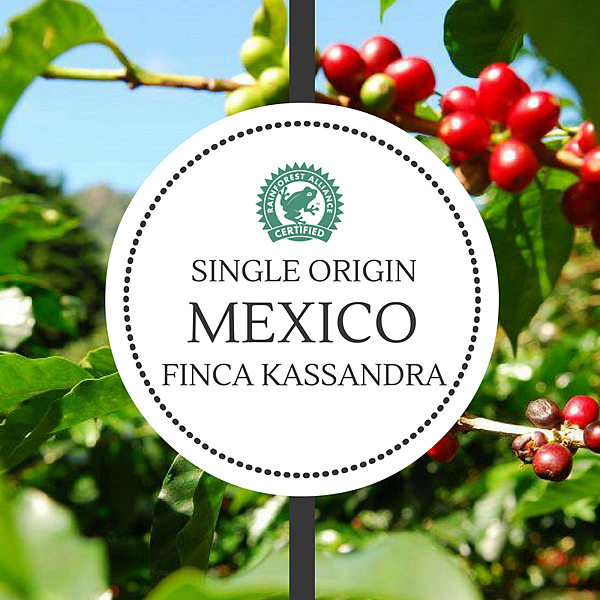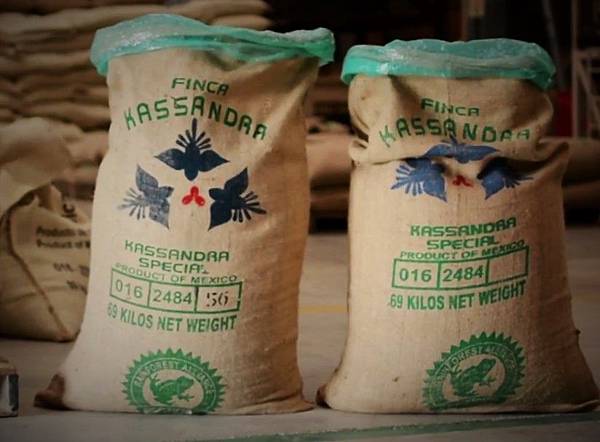close
墨西哥.卡薩德拉莊園.卡杜拉
Mexico Kassandra SHG Caturra


□產區:科爾多瓦Cordoba/維拉克魯斯Veracruz
□生產者:卡薩德拉莊園(Rivas Family/ Kassandra)
□海拔:1500
□品種:卡杜拉Caturra
□處理法:水洗
□等級:SHG
□風味敘述:果香,胡桃香,牛奶巧克力風味,甜甜的柑橘香…
□卡薩德拉莊園,國際雨林認證,2015COE第二名,2017COE第二名.莊園位於墨西哥最早開始種植咖啡的維拉克魯斯(Veracruz)產區,莊園主里瓦斯(Rivas)家族秉持著友善生態的態度,在園區中保留了27英畝的雨林,讓區域內的鳥類及野生動物居住,目前仍有大型的植樹計畫同步進行中.


□Brief History of Finca Kassandra.
Introduction
In the year of 1983 Mr. Guillermo Rivas and his father Mr. Andres Rivas bought the “Casa Blanca” ranch situated in Mexico in the state of Veracruz near the city of Huatusco. This was going to be where Don Andres was going to retire, since he was brought up in a farm this life style was reminiscent of his childhood. Andres Rivas Gomez had very humble beginnings in the outskirts of Mexico City in the area of Coyoacan, his father was a iron smith and his mother a native Mexican of the Tehuana tribe named Trinidad. As a side note Trini (which was her nickname) had a cousin named Matilde who was the employee of German immigrant who had a photography shop named Wilhelm Kahlo who was known in Mexico as Guillermo Kahlo. As you probably figured out by know Matilde and Guillermo married and had four daughters Matilde, Adriana, Cristina and the famous Frida Kahlo. Andres remembered playing as a young boy with his cousins. He would always mention to me how they all where known for their beauty and Frida for her Art.
Since there was very little money in his family and he had 10 brothers and sisters his only option to study was to enlist in the Mexican army where he quickly went up the ranks. Since he was very good with math he was invited to be part of the first generation of the Naval Engineering academy recently established in the state of Veracruz. Here he graduated in 1938 as a Naval engineer, soon hi met Maria Isabel Diaz who became his wife and they had three sons: Andres, Guillermo (in honor of his uncle Guillermo Kahlo) and Luis. He went on to participate in a passive way in the second world war transporting oil from the port of Tuxpan Veracruz to the port of Harlingen Texas. My grandfather was always telling stories about how they where afraid to be attacked by German U Boats during the journey up the gulf coast. I never believed him until I saw a documentary on TV aboaut the discovery and salvage of the remains of German U boats of the coast of New Orleans. After the war he became an electric engineer for the state owned electrical company were he worked from his early 30’s to the age of 65 when he retired.
“Rancho Casa Blanca” was originally used for cattle production, but since the region of Huatusco was well known for it’s high quality coffee the ranch was transformed in to a coffee plantation in the year 1990. The plantation was situated 1200 meters above sea level had an annual precipitation between 1400mm and 2000 mm, the rainy season is from June to February and the dry season is from March until May. The average temperature is 22 degrees Celsius, this are all perfect conditions for high quality coffee.
The total extension of the ranch was 46 hectares of which 38 where planted with coffee of the Caturra and Catuai varieties. With proper farming and management a yield of 30 Quintales per hectare was reached, all of which was sold in cherry for to local mills. Now Casa Blanca is 70 hectares, and it has it´s own dry mill since 2003.
Finca Kassandra is started.
At the end of 1996 a few cattle ranches where bought by Mr. Guillermo Rivas (my father) near “Rancho Casa Blanca”. These ranches where combined to form “Finca Kassandra” with an extension of 465 hectares (Actually it is 606 ha). Don Guillermo had a vision of turning “Finca Kassandra” in to the largest and best coffee Estate in the state of Veracruz. The plantation would have a high yield of “Estate Quality” Coffee, in order to ensure this quality all the coffee had to be grown and milled in “Finca Kassandra”.
Although “Finca Kassandra” was 10 Miles from “Casa Blanca Ranch”, situated on the road from Huatusco to the city of Coahtepec, the conditions where even more favorable for coffee production. The annual precipitation is about the same although the temperature is a couple of degrees cooler (19 degrees average a year) due in part to the fact that the elevation is between 1250 and 1450 meters above sea level.
The plantation.
To ensure the coffee varieties used in the plantation where of the purest form visits where conducted to El Salvador, Guatemala, Jamaica, Costa Rica, Colombia and Brazil. From this countries seeds of Pacamara, Caturra, Catuai and Typica (Jamaica Blue Mountain) varieties where acquired. The plantation was started in June of 1997 the beginning of the rainy season, since then 398 hectares have been planted and there 40 hectares of usable land that will be done by the year 2004. To ensure a refuge for wild life 27 hectares remained unplanted as virgin rain forest.
Since “Finca Kassandra” was originally used for cattle there wasn’t to many trees left by the previous owners, so it was decided to start an open sky plantation similar to those use in the high productivity farms of Costa Rica. This point of view has slowly changed for a number of reasons and currently a plan is under way to plant shading trees of local and foreign varieties. This helps the coffee during cold spells that occur now and then in Finca Kassandra.
Even though shade makes coffee trees less productive the plants do better, because they get less stressed with lower yields, the ground retains more water during the dry season and the quality of the cup is improved. Shade also protects trees from cold weather witch can be a problem in the higher altitudes of the plantation. The shade trees are home to many permanent and migrating bird species.
Now a days I have the honor of taking over the management of Finca Kassandra and Casa Blanca it is a big responsibility to continue with the legacy my grad father Don Andres started and my father has continued and passed on to me. We miss Don Andres and Doña Chabela but their spirit, values and stories live on in the trees and the coffee produced in Finca Kassandra.
The legend of Kassandra Pacamara
It all started back in 1994 when my father and grand father decided to start the Finca Kassandra and Casa Blanca plantation, and get the Rain Forest Alliance certification.
Since we had to protect and conserve the native forest in our land we decided to use a plot of native forest that had been untouched for centuries because I guess previous owners found the trees hard to mill and sell. It is between 1250 and 1400 meters above sea level. We have started to protect native species and found one Mexican elm that was thought to be extinct in our region due to deforestation but have now started efforts to replant among the Mexican oak trees where we plant Pacamara Coffee.
It was decided to plant pacamara variety since we where told it had a unique flavor, large beans and exiting aroma, only problem… very low yields.
Since the forest was very dense we decided to go forward with the project because you don’t get a lot of coffee under thick tree cover you do get very interesting flavour. Our bet was successful since about 8 years ago our micro lots of Pacamara have been wining competitions and getting peoples attention in Hong Kong, USA (Michigan), Korea and Australia.
We only produce about 60 bags a year but they are highly sought after and commend prices over 3.50 USD per pound on average year to year. That is FOB at our farm in Veracruz!!!!
As for the process we take care in selecting the cherries at their peak we always end up harvesting pacamara last because we wait to pick all the cherries ripe and dark wine red!!! this makes for very interesting flavors, of plum, chocolate, pear, citrus and some wine notes. The aroma is always a characteristic of our pacamara although some people say it needs some body, I personally enjoy it straight but some times blend it with Kassandra Peaberry for my roasted clients here in Mexico that some times deserve a treat.
I never blend green, since the shape of pacamara long and narrow with a couple of rounder beans like the original Typica varieties, does not go well when roasted at the same time than some other coffees. You will under roast the other coffee or might burn the long thing pacamara beans.
If blending we prefer to do it with roasted coffee not green before roasting. This is also because we like to roast Pacamara on the lighter side, but to each his own!!!!
In the mill we de-pulp pacamara with specially calibrated de-pulping machines that use little water of the Penagos variety from Colombia. We then rest to get some of the mucilage of (but not completely since our clients prefer some of the sweetness of the honey that is in the mucilage that why some call it honey coffee process) but not all. Then we wash and proceed to the dryers, we use guardiola type dryers or cylindrical dryers but never exceed 60 degrees centigrade to ensure we keep the embryo of the coffee bean alive. In theory this means the coffee could still germinate after this drying if left with the parchment on it.
Since we have a pacamara we have to select the bean size though special screens and get over 80% of the beans above screen size 19, usually coffee in Mexico is graded 80% over screen 16 but for Kassandra Pacamara we use the larger beans, even though the smaller beans we have found also have the same aroma and flavor but our clients prefer this method and we always comply to their demands.
(https://www.allianceforcoffeeexcellence.org/en/cup-of-excellence/country-programs/mexico-program/2015/2/kasandra-gabriel-bernard-rivas-ross/ )
(圖文彙整/咖啡舖子Ryan Chien 2017/08/14)
(圖文彙整/咖啡舖子Ryan Chien 2017/08/14)
文章標籤
全站熱搜



 留言列表
留言列表


